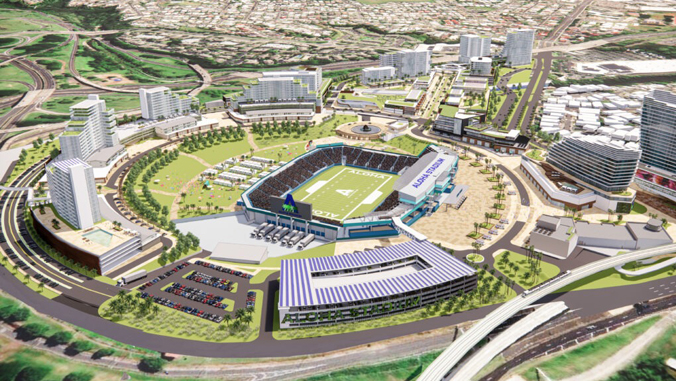
The request for proposals (RFP) for the New Aloha Stadium Entertainment District Project (NASED) was issued on December 14, marking the launch of the procurement process to identify a developer to build the new Aloha Stadium and the surrounding district. The RFP is for an integrated public-private-partnership (P3) project and the state says the new Aloha Stadium is on track to open on time for the 2028 University of Hawaiʻi football season opener against Kansas.
“The new Aloha Stadium will provide our Rainbow Warriors with a kind of modern venue that will enable Hawaiʻi’s team to play at the FBS (Football Bowl Subdivision) level competitively for years to come and attract the kind of talent that will honor our state and delight our fans,” UH President David Lassner said.
The issuance of the RFP is the first in a three-stage procurement process which is intended to result in one or more contract(s) with a single private entity to be engaged as a master developer to masterplan and deliver the NASED project. The release of the RFP follows the market sounding process that began in June 2023 to gauge interest and elicit feedback from prospective offerors.
“We were very excited with the interest expressed by potential partners during the market sounding,” said Brennon Morioka, Stadium Authority chair and UH Mānoa College of Engineering dean. “We received responses from some world-class teams, and our team worked very hard to address the issues raised during the process.”
The deadline for proposals will be in summer 2024, with the selection of a preferred offeror targeted for fall 2024, and final execution of an agreement targeted for summer 2025.
The goal of NASED to be delivered as an integrated public-private-partnership (P3) project follows UH’s first P3 project, the Walter Dods, Jr. RISE Center, which opened in August 2023, with UH’s second project—the Residences for Graduate Students at UH Mānoa—scheduled to be completed in fall 2025.
Key features of the RFP include:
- The master developer will be responsible for designing, building, operating and maintaining the new Aloha Stadium with a minimum of 25,000 seats, premium suites, a club lounge and loge boxes. The master developer will be entitled to generate revenue to support stadium operations and maintenance by marketing the stadium during the limited number of dates not reserved by the state for UH and high school football and related events.
- The expectation is that the master developer will design and build the new stadium using allocated state funds and, potentially, master developer funds for any additional stadium enhancements.
- The master developer will also have the right and obligation to develop a portion of the surrounding district into a mixed-use development in line with the state’s vision of a live, work, play and thrive community replete with residential units, commercial and retail spaces, hotels, gathering spaces and other enhancements. Revenue from such development may supplement allocated funds for the stadium construction and to fund ongoing operating and maintenance costs.
- This approach utilizes the current appropriation of $400 million and has the objective of transferring responsibility for containing construction and maintenance costs to the private sector, thereby reducing the risk and financial burden on local taxpayers. The private sector also benefits from the revenue upside of its own effective and compelling utilization of the new Aloha Stadium.
- The state will retain fee ownership of all the land comprising the NASED site. The state will also own the new Aloha Stadium and all of the district infrastructure improvements.
NASED concept flyover (courtesy: Crawford Architects)

